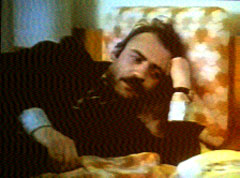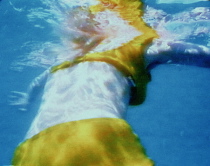
It’s interesting living with someone who’s an information junkie and a pack-rat to boot. In addition to the piles of books, journals and magazines you manage on a daily, weekly …and lifetime basis, you’re likely to get something time-warpy thrown at you occasionally that gets you all excited — until you chase it down and find out the information’s so old it’s wrong…and big disappointment ensues. (image top is from Shirin Neshat’s “Soliloquy,” 1999)
Take last week, for example. My husband, Steve says “Here, this is for you to read but I want it back.” He then plops down on the kitchen table a two-month-old NY times Arts and Leisure section (Aug. 17, 2003) opened to page 5 which had his designated story of interest. The article was about some filmed versions of classic plays like “A Delicate Balance” that are now available on dvd. We’re always looking for non-Hollywood fare to watch and this is great news. 
I’d not seen the Aug. 17 Times so flipped to the art page and found something even more exciting. There, in a story by Greg Allen who runs greg.org, I read about the benevolent bootlegging of video art by artist and self-taught video expert, Chris Hughes, who was single-handedly doing for video art what Napster did for music — making it free and available via his website. Apparently, not only did the earnest and young Hughes have high quality videos that he was making available in a gesture of sharing and public spiritedness, but he had a deep catalog of 1,500 works that included early pieces by Vito Acconci and Yoko Ono as well as new stuff by Pierre Huyge and Gillian Wearing and, stop the presses, Matthew Barney. (image above is from Pierre Huyghe’s “L’Elipse,” 1998)
This was such thrilling subversion of the marketplace that I was stunned. How could this kid get away with it?
Well, the answer is that he couldn’t, not after Aug 17, 2003 when the story ran and presumably some lawyers got involved.
I never saw Hughes’s website before Aug 17, but, when I went to the site, I found that all sharing of videos had ground to a halt on Aug. 18, 2003.
Nothing was accessible except the list of 1,500 titles, a bunch of links to websites where you could purchase videos — and a pitiful plea by Hughes that you go to the websites and purchase videos as a way of supporting the art form. I went to a couple of the distribution sights like light cone operating out of Paris and while the site was navigable and bi-lingual and prices were listed (in euros or French francs), I didn’t know anything about the artists or the videos, there were no samples to view and so I was kind of at sea. (image left is from Pipilotti Rist’s “Sip My Ocean,” 1996)
Hughes explained his motivation to Allen saying that video art’s roots were in the “free trading of experimental material” and, by gum, he was going to carry that tradition forward. “Video art specifically arose out of a desire to create an immediately accessible, infinitely reproducible art form…The viral quality [my emphasis] of video is essential to the nature of its artistic use,” Hughes told Allen.
I have to think that Hughes’s free distribution system, which was indeed viral, was nevertheless harmless to the artists and was actually helpful in getting video out there to an audience which, in spite of all the brouhaha about a few big name video artists, is still pretty small. Hughes’s system of downloading, thus could be a form of art education.
Not that I’m bitter but I’d like to know why Greg Allen outed this kid. Who benefits? Not the public, certainly.
I gave Steve back his newspaper. We’ll probably go buy some of those filmed plays. At $24.95 at kultur.com we can afford it.
Steve Jobs found a way to overcome the legal/copyright issues for music with iTunes, making songs available online for a buck a song. I wonder if he’d consider an iVideo venture that would work the same way with video art. I’d buy.









